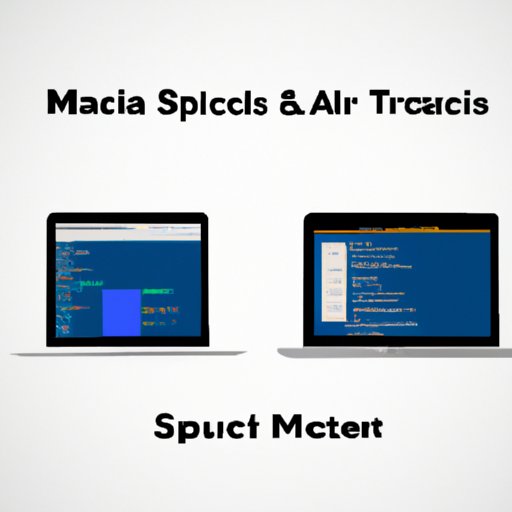
I. Introduction
If you’re a Mac user, you’re probably already aware of the split-screen feature. It allows you to view two windows side-by-side on a single screen, which can be particularly useful when you’re working on multiple projects or need to reference different applications at the same time. However, not everyone knows how to use this feature to their advantage. In this article, we’ll provide a comprehensive guide to split-screen on Mac, including step-by-step instructions, keyboard shortcuts, third-party applications, tips & tricks, and more.
II. Step-by-Step Guide
To activate the split-screen feature on a Mac, follow these steps:
- Open the applications you want to use in split-screen mode.
- Click and hold the green full-screen button (the button that looks like a plus sign) in the upper-left corner of one of the windows.
- Drag the window to the left or right side of the screen, depending on where you want it to appear in split-screen mode.
- Select the second app that you want to use in split-screen mode.
- Click and hold the green full-screen button on the second app, then drag it to the opposite side of the screen.
Here’s a visual guide to using split-screen mode:

III. Keyboard Shortcuts
If you’re looking for a quicker way to activate split-screen mode, you might prefer to use one of the following keyboard shortcuts:
- Split Screen: Control + Command + F
- Move Window to Left Half of Screen: Control + Command + Left Arrow
- Move Window to Right Half of Screen: Control + Command + Right Arrow
These keyboard shortcuts are especially useful if you frequently use split-screen mode and want to streamline the process. However, it’s worth noting that they can take some time to get used to, so you may want to practice a few times before relying on them exclusively.
IV. Third-Party Applications
In addition to the built-in split-screen mode on Mac, there are also several third-party applications that can help you manage multiple windows on a single screen. Some of the most popular options include:
- Bettersnaptool: allows you to snap windows to specific areas of the screen and create custom keyboard shortcuts.
- Divvy: allows you to create custom layouts for your windows and switch between them quickly.
- Magnet: allows you to snap windows to specific areas of the screen and switch between split-screen mode and full-screen mode easily.
If you’re interested in using a third-party application, it’s important to do your research and find one that suits your needs. Each application has its own unique features and drawbacks, so it’s important to find one that aligns with your workflow.
V. Comparison of Split-Screen Features
MacOS split-screen feature is one of the most convenient options available for managing multiple windows on a single screen, but it’s worth comparing it to split-screen features on other operating systems to get a better sense of its strengths and weaknesses.
For example, Windows 10 has a split-screen feature that works in a similar way to the Mac version, but the positioning of the windows is limited to certain areas of the screen. On the other hand, Ubuntu Linux allows you to snap windows to specific areas of the screen, much like some of the third-party applications available on Mac.
Ultimately, the split-screen feature you choose will depend on your operating system and personal preferences. However, it’s worth noting that there are many options available, so don’t be afraid to experiment and find one that works for you.
VI. Video Tutorial
If you’re a visual learner, you might prefer to watch a video tutorial on how to use the split-screen feature on your Mac. Here’s a step-by-step guide in video format:
Video tutorials like this one can be especially helpful if you’re new to split-screen mode, as they provide a visual walkthrough of the process. They can also be useful if you’re unsure about a particular step and want to see it in action before trying it yourself.
VII. Tips & Tricks
Finally, here are a few tips & tricks for using split-screen mode on your Mac:
- If you want to use more than two windows in split-screen mode, you can create a custom layout by dragging windows to specific areas of the screen. Alternatively, you can use a third-party application like Divvy.
- If you find that one window is taking up too much space in split-screen mode, you can adjust the size of each window by clicking and dragging the divider between them.
- If you need to switch focus from one window to the other, you can do so by clicking on the window you want to use.
These tips & tricks can help you make the most of split-screen mode on Mac and streamline your workflow.
VIII. Conclusion
Split-screen mode on Mac is a powerful tool for managing multiple windows on a single screen. Whether you’re working on a project or need to reference multiple applications at the same time, split-screen mode can help you stay organized and focused. By following this comprehensive guide, you should now be able to use split-screen mode with ease. If you’re looking to further expand your split-screen mode expertise, consider experimenting with third-party applications or customizing your workflow with keyboard shortcuts and other tips & tricks.




